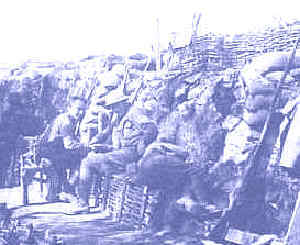


83rd Division, AEF
[Parent Unit]
|
332nd Infantry Regiment
331st Field Hospital
|
The Yanks Come to the Italian Front
The 332nd Infantry Regiment, 83rd Division, with attached medical and supply units, was sent to the Italian front in July 1918 in response to urgent requests from the Italian Government. Its principal missions were to build up Italian morale and to depress that of the enemy by creating the impression that a large force of Americans had reached that front and was preparing to enter the battle line and to take an active part in the fighting.

American Doughboys in the Trenches
Along the Piave
The regiment was first stationed near Lake Garda, where it trained in methods of warfare suitable for the difficult mountain terrain which comprised the greater part of the Italian theater of operations. Early in October it moved to Treviso, behind the Piave River Front, where it was assigned to the Italian 31st Division. From there, for purposes deceiving the enemy, it staged a series of marches in which each battalion, with different articles of uniform and equipment, left the city by a separate road, circulated during daylight hours in exposed positions for both the Italians and Austrians to see, and returned after nightfall to its station at Treviso in as inconspicuous a manner as possible.

Vittorio-Veneto and Victory
On October 24th, the opening day of the Italian Vittorio-Veneto offensive, the Italian 31st Division with the 332nd Infantry attached was in reserve. It joined in the pursuit of the fleeing Austrians on October 29th as part of the British XIV Corps of the Italian Tenth Army; the American regiment forming the advance guard of the corps. On November 3, after several hard marches, the 332nd Infantry established contact with an enemy rear-guard battalion which was defending the crossings of the Tagliamento River near the village of Ponte-della-Delixia.

Training with the Italian Army for
River Crossings
Early on November 4th the 2nd Battalion crossed the river on a narrow footbridge and after a brief struggle captured the Austrian position on the far side. Continuing to move forward along the Treviso-Udine railroad, the 2nd Battalion occupied the town of Codroipo where it took possession of large stores of munitions and supplies. In this, their only offensive operation, the 332nd Infantry had one man killed and four wounded. At 3:00pm, November 4th, when the armistice between Italy and Austria-Hungary became effective, the leading American elements were at Villorba.

The Doughboys Cross the Tagliamento River
After this Armistice the American troops formed part of the Allied force stationed in Austria and along the Dalmatian coast. The 1st and 3rd Battalions were at Cormons near Gorizia. Later in November the 1st Battalion was ordered to go to Treviso and the 3rd Battalion to Fiume, Austria. The 2nd Battalion was stationed at Cattaro, Dalmatia and a detachment from it was sent to Cetinje, Montenegro. In March 1919 the regiment was assembled in Genoa and by April 4th its last elements embarked from that seaport and Marseilles for the United States.
In addition to this American infantry force, 30 American ambulance sections, a base hospital and 54 airplane pilots also served with the Italian Army. The American pilots, as members of Italian bombardment squadrons, engaged in bombing raids behind the Austrian lines, being especially active during the progress of the Vittorio-Veneto offensive.
|
Sources and Thanks: This article is quoted from two official documents: American Armies and Battlefields in Europe and Vol. 2 of the Order of Battle of the United States Land Forces in the World War, 1917-1919. Photos were contributed by Ray Mentzer and Herb Stickel.
|

|




